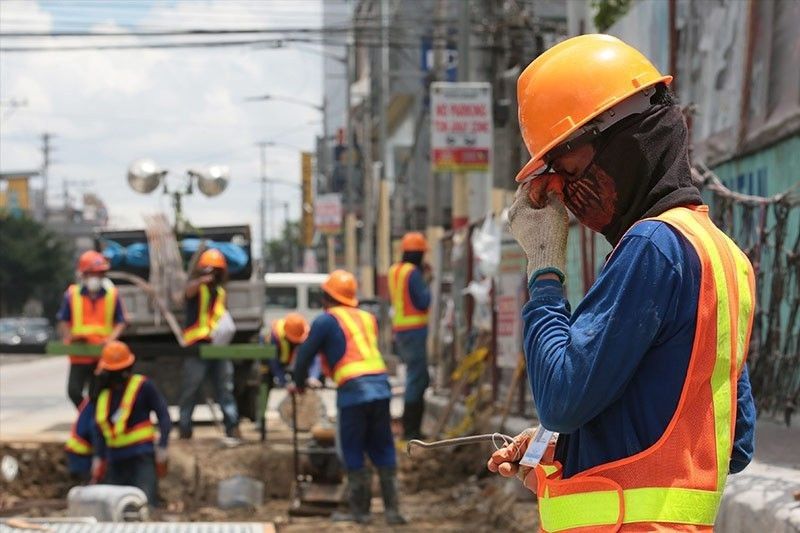Gov’t urged to pursue more PPP projects amid growing fiscal burden
By Beatrice M. Laforga | Business World | July 27, 2021 12:32 am

Worker presses his forehead as he is seen at a road reblocking activity in Caloocan on Apr. 30, 2020.
The STAR/Michael Varcas, file
THE PHILIPPINE government should consider more public-private partnership (PPP) infrastructure projects as it faces increasing fiscal constraints due to the pandemic, experts said.
Experts from international organizations, ASEAN+3 Macroeconomic Research Office (AMRO), Asian Development Bank (ADB), and the International Monetary Fund (IMF) acknowledged that well-designed PPPs can accelerate the country’s “Build, Build, Build” program.
“The Philippines has made considerable progress in infrastructure investment in recent years… PPPs play an important role in infrastructure programs. Well-designed and properly implemented PPPs can supplement government-funded projects by mobilizing private capital and bringing in the private sector’s construction and managerial capacity,” IMF Representative to the Philippines Yongzheng Yang said in an e-mail last week.
The Duterte-led government had previously steered clear of PPPs due to allegedly disadvantageous provisions such as subsidies and guarantees.
Mr. Yang said the state needs a sound PPP framework and build enough capacity to manage fiscal costs and risks like contingent liabilities that could emerge from such an approach.
Ernesto M. Pernia, a former socioeconomic planning secretary under the Duterte administration, said the government should tap the private sector to help with its massive infrastructure drive, without adding more pressure on its fiscal standing.
“I have always tended to favor smartly chosen PPP projects… they can ease the burden on the government’s fiscal position, while making sure the costs and benefits are well balanced between public and private sectors such that it’s a win-win arrangement for both. More PPP projects should be encouraged, which is also ADB’s policy stance,” Mr. Pernia said in a text message on Friday.
In an e-mail, Byunghoon Nam, a senior economist at AMRO, said he sees no reason why the Philippines cannot take advantage of PPP-type projects, “as long as proper safeguards are in place to ensure that they are well designed and implemented.”
When the pandemic hit last year and state resources were stretched thin, economic managers last year signaled their willingness to be more open to PPPs as a funding option for its infrastructure push.
Fitch Ratings earlier this month flagged growing fiscal risks faced by the Philippines, as it revised the outlook for the sovereign rating to “negative.”
The credit rater projected the country’s general government debt will rise drastically to 54.5% of gross domestic product (GDP) in 2022 from just 34.1% in 2019 as it increased borrowings for its pandemic response.
Fitch Ratings said it will continue to “monitor the evolution of the fiscal deficit and debt levels, as the balance between fiscal consolidation and ongoing government spending to support economic recovery will be an important consideration for the (credit) rating.”
ADB Philippines Country Director Kelly Bird said the PPP program was “reinvigorated” by the administration of the late President Benigno S.C. Aquino III, allowing the government to pursue more infrastructure projects.
“But because of the scale of the infrastructure gap, private sector and PPPs will be both inadequate and insufficient to fill the funding gap. Public spending is necessary for large, complex projects especially in mass public transportation,” Mr. Bird said.
He emphasized the need for a balanced mix of funding sources to provide sustainable support for the massive pipeline of infrastructure projects.
“Government’s optimal infrastructure financing strategy must include a combination of public financing through the national and LGU (local government unit) budgets, private sector financing, and PPPs. ODA (official development assistance) is also another key support for infrastructure financing,” he added.
The Duterte administration’s priority list of 112 flagship infrastructure projects worth P4.687 trillion includes 20 unsolicited PPPs with a total estimated cost of P1.505 trillion.
This made PPP as the second-biggest funding source, next to foreign loans or ODA, which accounts for 54 projects worth P2.612 trillion.
Other 10 projects worth P336 billion were funded through a mix of PPP and other funding sources like ODA and the state’s coffers.
Source: Business World
